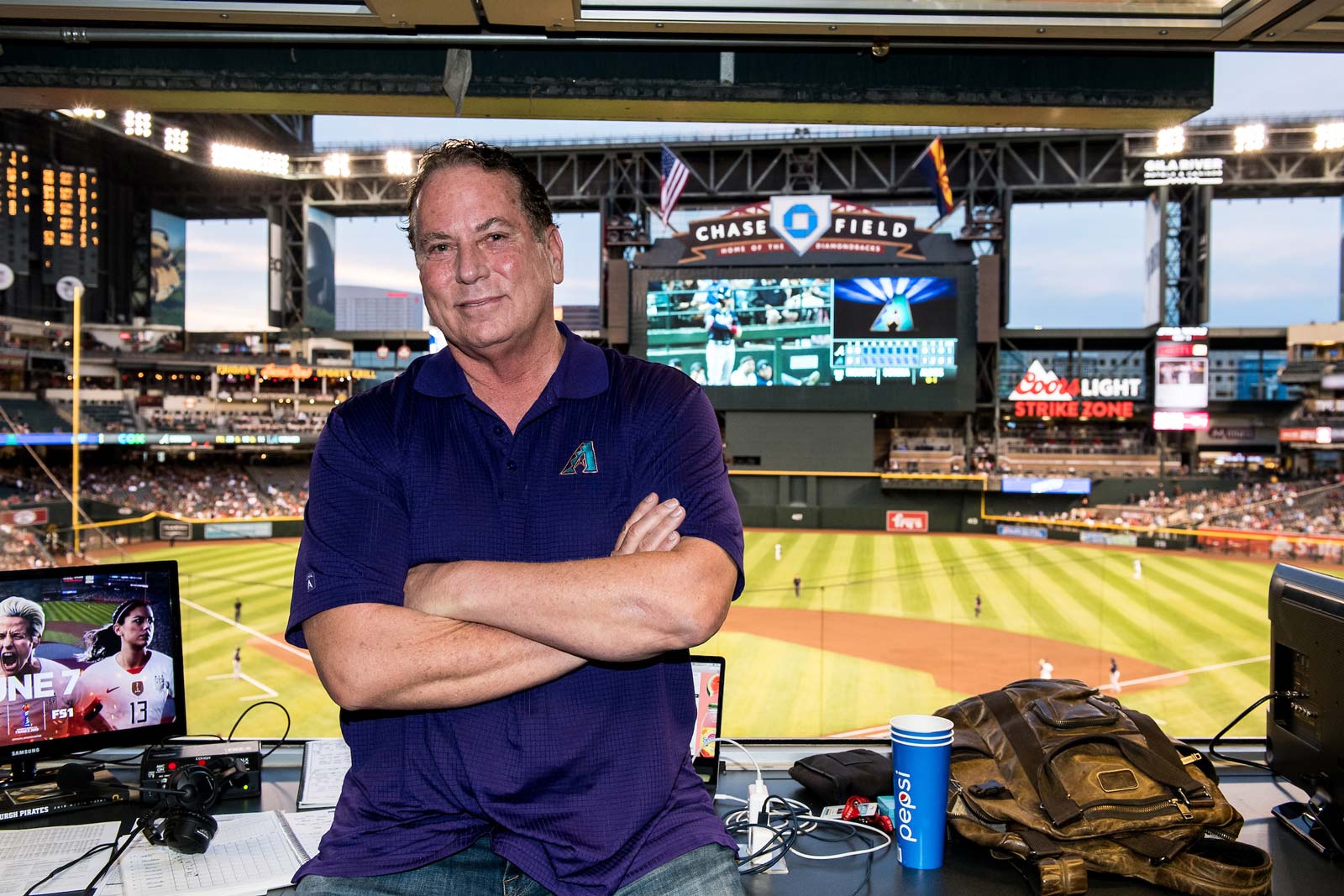
Seventh in a series
Before they ever bonded as teammates, Tom Candiotti shared one thing in common with Hideo Nomo: Both had unusual pitching styles.
When Nomo joined the Dodgers in the spring of 1995 as Major League Baseball's first Japanese player since left-handed pitcher Masanori Murakami left the San Francisco Giants in 1965, he brought with him a long list of accomplishments from his five seasons with Kintetsu Buffaloes.
At the same time, Candiotti was an established big-league pitcher, one who relied on the seldom-used knuckleball as his primary weapon. Candiotti broke into the majors with the Milwaukee Brewers in 1983, a season after they lost the World Series to the St. Louis Cardinals. And when the 1995 campaign kicked off, Candiotti, then 37, was closer to the end of his career than the beginning, having already collected 110 of his 151 MLB victories. He retired in 1999.
Over the course of the headline-grabbing 1995 season and beyond, Candiotti and Nomo established a friendship defined by laughter and mutual respect as Los Angeles Dodgers teammates.
In a recent conversation with JAPAN Forward by phone from his home in Arizona, Candiotti looked back at the way Nomo interacted with his teammates and how he reacted to the constant media spotlight during his first season in MLB. The longtime Arizona Diamondbacks radio analyst also marveled at how focused Nomo was on his craft, even if he didn't always take himself too seriously.
Candiotti, an articulate observer of baseball happenings in the 20th and 21st centuries, also underscored why Nomomania was such a big deal as it occurred, and why it is a significant historical development in baseball.
"I've never seen anything in baseball like that," Candiotti declared. "It was just beyond amazing what was happening and transpiring that year in 1995.
"I was in baseball, I was actually in the minor leagues when Fernandomania was hitting [in 1981] in L.A.," he added, referring to Dodgers left-hander Fernando Valenzuela, who baffled batters with a nasty screwball. "And that was a big thing. I wasn't part of that. ... But I was in there with Hideo and the stuff that was just going on was just mind-boggling."
Such as?
"The people that would just come and flock and see Hideo," Candiotti noted.
Nomomania also impacted the food selections at Dodger Stadium, according to Candiotti, who recalled the departure of a Taco Bell inside the ballpark to make room for a Yoshinoya.
Candiotti also remembered that Dodgers manager Tom Lasorda altered his eating habits after Nomo joined the ballclub.
"Tommy would always like to have a pre-game meal in his office," Candiotti said. "He'd have food catered in. Most of the time it's pasta. So [before] the games that Nomo would pitch, he would have Chinese food in there, Japanese food. It was like, we're having Yoshinoya now in the locker room.
"So this is great, are you kidding?" he added with a laugh.
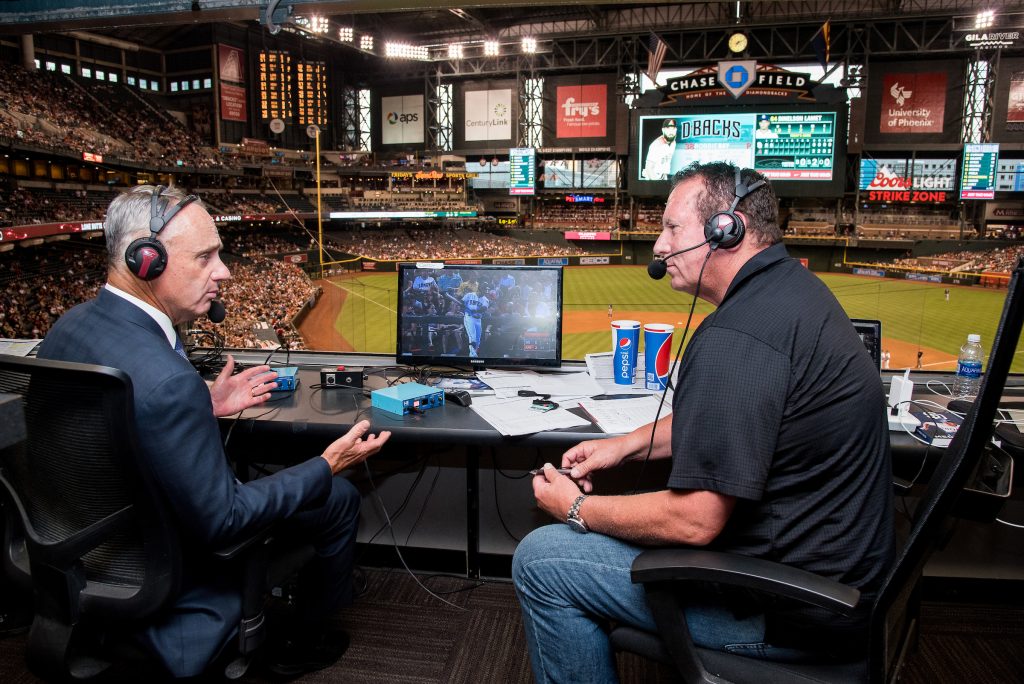
Arizona Diamondbacks radio analyst Tom Candiotti (right) interviews MLB Commissioner Rob Manfred in 2017. Credit: Arizona Diamondbacks
'A Great Teammate'
Beyond Nomo's National League-best 236 strikeouts, his 13-6 record, his stellar 2.54 ERA and his NL Rookie of the Year award in 1995, the Kansai native's enjoyable interactions with his teammates resonated just as much for Candiotti.
In 1995, in terms of observing Nomo and the buzz he created throughout baseball, Candiotti insisted that the experience was a joyride.
"One of the coolest things about it was just how humble and what a great teammate Hideo was," Candiotti said. "A lot of guys when they are going to get all that media attention that he was getting that comes with not only being successful but just being different, he never wanted it to bother the team.
"So when he had the photographers following him everywhere in places where they are not really allowed to go, like they are not supposed to go on the field or past a certain area. Or he's going to play catch in the outfield and they are trying to follow him. And at that time in baseball, you weren't allowed to do that, and he would stop them and talk to them and then send them away. He didn't want that kind of attention [around] the team."
And despite the language barriers, Nomo triggered laughter when interacting with his teammates.
In addition to his world-class pitching talent, he brought joy to the team.
"He used to crack me up every single day," Candiotti says now.
What's more, "he wanted to learn [American] slang."
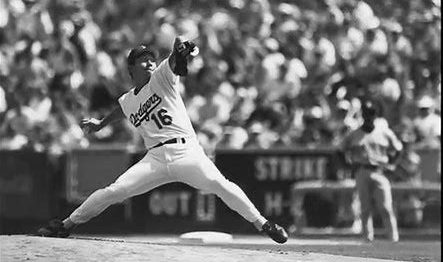
Dodgers hurler Hideo Nomo pitches in 1995. Credit: YouTube
Dodgers Play Practical Joke on Nomo, Fellow Rookies
Just a few miles from Wrigley Field, home of the Chicago Cubs, is Grant Park, where there's a statue of General John A. Logan, who was a Union Army soldier in the Civil War, riding a horse.
Nothing unusual, of course, about a statue in a big public park. But what makes the park unique is how it connects to Nomo's experience as a Dodgers rookie. And the team took part in a baseball tradition as part of its rookie hazing during its annual visit to Chicago.
Here's how Candiotti explained it:
There's a tradition there that the visiting team's rookies have to spray the private parts of the horse the color of your team. So if, for instance, the [San Francisco] Giants were in there before us, the private parts of the horse would be sprayed orange and black. Those are the team colors.
...And so we had all the rookies that were on the team at that particular time, so it was probably three or four guys, and I had a video camera, and we would buy spray paint for 'em and take them there, and they would have to spray the horse. That was like an inauguration for rookies.
Naturally, several veteran players who showed up for the hazing wanted to embarrass the rookies after they spray-painted the horse.
"And so, as you do it, somebody has to yell out, 'Run, here comes the cops,' so everybody just runs. It's all planned," Candiotti said.
"The rookies are scared to death, and they take off."
This incident spilled over until the next day, when the Dodgers traveled by bus to Wrigley Field. All of the players saw the vandalized horse, confirming what took place.
Once inside Wrigley Field, the well-orchestrated hazing morphed into a temporary crisis.
Said Candiotti: "Tommy Lasorda, who's the best at this, calls a team meeting and he comes out and he says, 'Mr. O'Malley [team owner Peter O'Malley] is very upset. Apparently, somebody has ruined some of the property of the City of Chicago and they know it's Dodger players. Somebody saw some guys running, and I need to know who they are right now. Whoever it is, stand up.'
"So hardly anybody's gonna stand up, right? But Hideo stands up ... and then his interpreter [Michael Okumura] is really crying now, 'cause the cops are in there and the cops are going to come over and put the cuffs on 'em and take 'em away, right? It's all fake, but this is what is done."
Stadium security guards played the role of cops for this prank. They walked into the Dodgers clubhouse with Lasorda. One of the faux police handcuffed Nomo, "and they start taking him away," Candiotti recalled.
Nomo's reaction?
"He's got that smirk on his face. He's just laughing, and then all of a sudden, his interpreter [blurts out], 'He's not the only one. It was him, him, him and him.' He starts pointing guys out, and I'm going, 'Oh, my God. He started ratting on everybody else that was there.
"And Hideo the whole time is laughing. He's smiling. He's going away with whatever, and of course right when you get to the door the cops will take the cuffs off and say, 'Ha-ha, just kidding...' "
Indeed, even though he was a part of the butt of the joke, the prank illustrates how Nomo embraced humor to bond with his teammates.
Or as Candiotti put it: "Anything that was kind of part of the team he enjoyed."
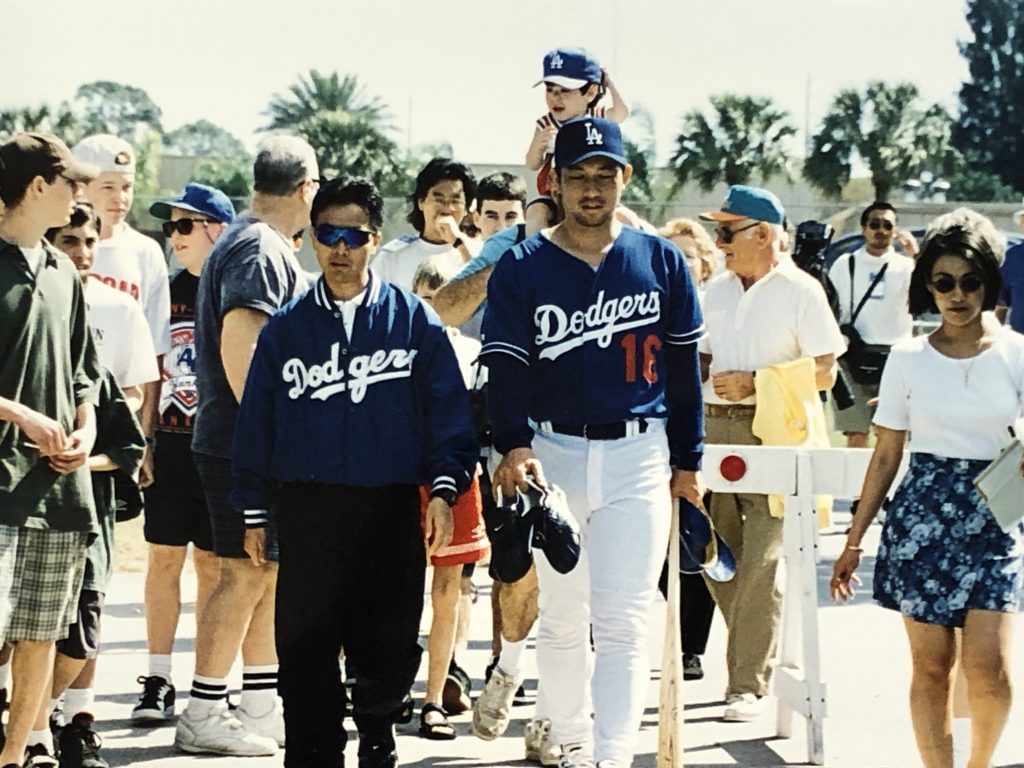
Hideo Nomo (16) was the center of attention at training camp in Vero Beach, Florida, and throughout the 1995 MLB season.
Dominating Performer in Debut Season
Candiotti is still in awe of how well Nomo handled the pressure heaped on him day after day during the long 162-game MLB season.
"It was huge, and not only did he succeed, he was an All-Star," said Candiotti, who joined the Diamondbacks radio broadcast crew in 2006. "He was just phenomenal in every way, and he did it in a unique style. He did it his way."
Yes, the former knuckleballer is correct. This reporter, who has watched thousands of baseball games over the years, hasn't seen another pitcher who mimicked the entirety of The Tornado's body-contorting delivery.
Nomo's unique approach to the game.
"Everything was unorthodox, and it was something that American ballplayers really hadn't seen," Candiotti pointed out. "You know, Luis Tiant was maybe a little unorthodox ... but not to the extreme that Hideo was.
"It was just unreal, and then just how unhittable he was. It was like a time where he's striking out double digits every night."
A snapshot of the then-Dodgers rookie's brilliance: That June, he went 6-0 with a 0.89 ERA in 50 1/3 innings with 60 strikeouts, closing out the month with back-to-back shutouts. He threw a two-hitter and fanned 13 against the Giants on June 24, followed by a six-hitter and another 13-K performance against the Colorado Rockies on June 29. (And you can't forget he whiffed 16 batters in eight overpowering innings against the Pittsburgh Pirates on June 14.)
Specifically looking back at Nomo's amazing June, Candiotti stated that it was a stretch of dominance that rivaled anything he'd ever seen.
"During that stretch, it was amazing if anybody even hit a foul ball off the guy," Candiotti said of Nomo. "It was such a dominating performance.
"He's not only just winning games, but he's dominating games and it just kind of added to the mystique," Candiotti observed while noting the major hype of Nomomania also carried over to the other side of the Pacific Ocean with big-screen TVs in several Japanese cities attracting large crowds for live broadcasts whenever Nomo pitched that year.
Japanese travel agencies experienced a big spike in business that year, too, organizing trip after trip to America tailored for fans to watch Nomo and the Dodgers play.
"And after the games, it was just crazy," Candiotti said of people wanting to meet and greet Nomo. "There's a few times I even gave him a ride home ... to his condo that he had on Wilshire Boulevard."
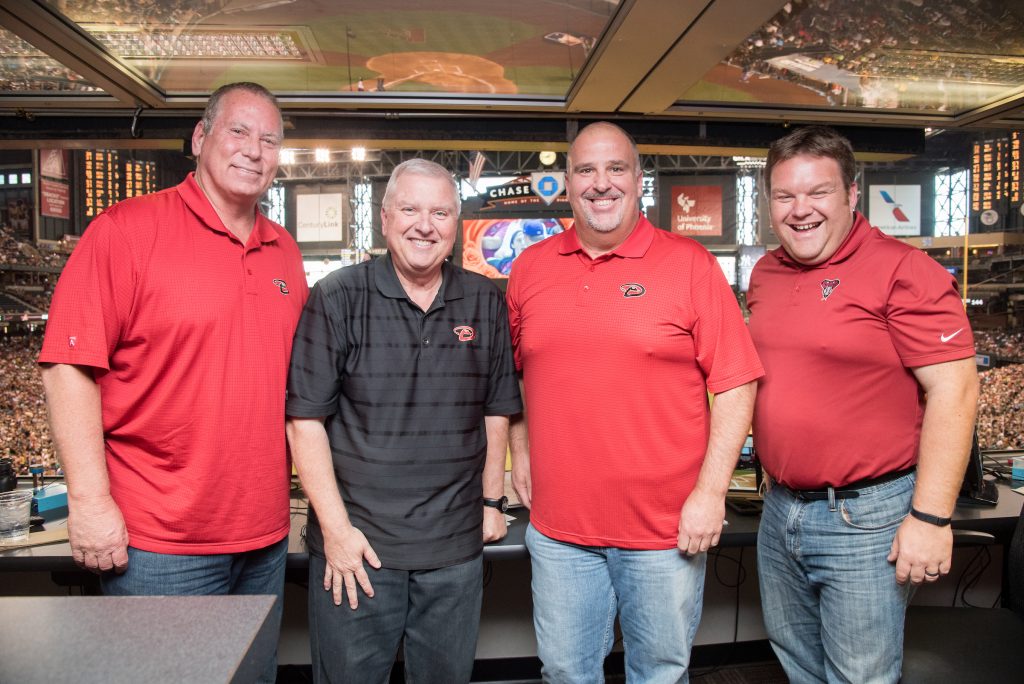
Tom Candiotti (left), a radio commentator for the Arizona Diamondbacks since 2006 seen with his broadcast colleagues, says Hideo Nomo's sense of humor was an endearing characteristic of his personality during his MLB career. Credit: Arizona Diamondbacks
What Made Nomo So Difficult To Hit
In talking with Candiotti, one immediately discovers his deep appreciation for the craft of pitching. He also has the ability to break down the subtle nuances that make one pitcher unique in comparison with another. Or what makes him succeed.
In describing Nomo during the height of Nomomania, Candiotti the analyst was at the top of his game.
Listen to his description:
I just kept watching him get better and better and better. And he wasn't coming out after six, or seven, or eight innings. He was going nine innings, and game's over. Half the time, the game's over before it started. He was that dominant...
You see most of the dominant pitchers, like in the history of baseball, they've all been guys, whether it's Nolan Ryan, or Tom Seaver, or Randy Johnson, guys with big fastballs, and Hideo had a good fastball. But his splitter, that was [the] pitch. He was doing it with just a devastating splitter, and it was just unhittable.
As great as Nomo was pitching in June 1995, one wonders if that elevated his confidence for the latter half of the season.
"I think more than anything, it just took him a little bit of time to get himself into a comfort zone," Candiotti commented before adding, "He was such a great teammate that you wanted him to win, you rooted for him every time he was gonna take the ball. You wanted to sit next to him in the dugout because he was funny—at least I did."
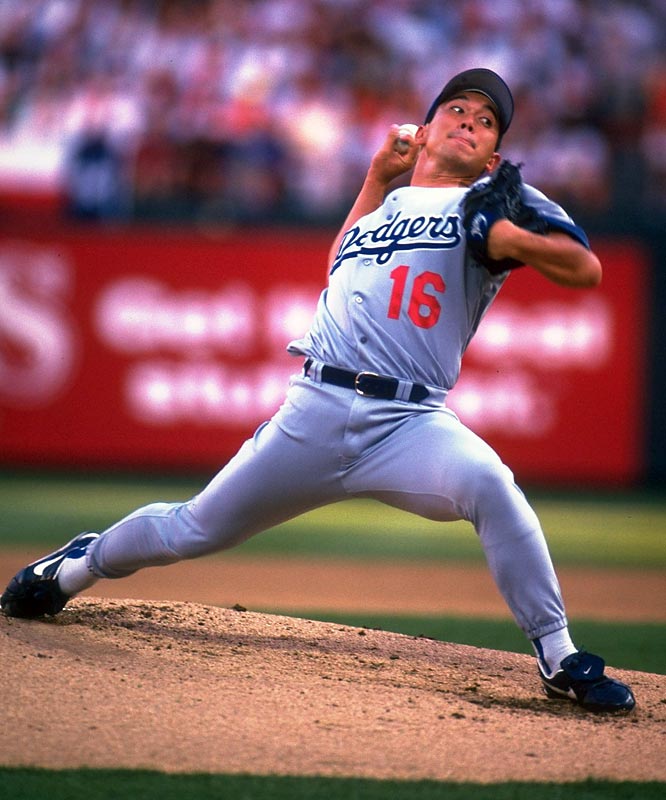
Hideo Nomo was the 1995 National League Rookie of the Year.
A Master of Poise
In watching Nomo make 28 regular-season starts in 1995 and also get the nod as the NL's starting pitcher in the MLB All-Star that July, Candiotti marveled at how composed his teammate was on the mound.
Specifically, the Diamondbacks broadcaster noted "he looks the same whether it's a crucial situation or like he's winning a game 10-0. He's got the same mannerisms. Nothing changes. You take a look at him, and some pitchers you can look at, and you can see their stress level and you can kind of tell how the game's going. With Hideo, you couldn't tell that. He had the same mannerisms, he pitched the same way, it didn't matter what it was, you know, he had his emotions in check so well that you knew he could handle a big game like that [the All-Star Game]."
Watching the Midsummer Classic on TV while on a short vacation in Las Vegas, Candiotti beamed with pride as Nomo handled the marquee assignment with poise.
"I remember just being so proud," Candiotti remembered, "that, gosh man, this guy deserves everything he gets. He's so deserving of this. ... This is about Hideo here and it's such a showcase for him and for Japan. It was phenomenal."
Reflecting on Nomo's deceptive delivery and aforementioned dominance, Candiotti's long tenure as an analyst enhanced the overall picture of The Tornado's inimitable one-man play.
"When I look at just the way he pitches, that this is a very, very uncomfortable at-bat guys are going to get," Candiotti told JAPAN Forward, referring to Nomo in 1995. "It's out of the normal. They can't see the ball. He hides the ball better than anybody in baseball..."
Nomomania brought positive energy to MLB a year after a bitter strike forced the cancellation of the 1994 World Series, and it showcased a master of deception on the mound, a pitcher who blazed a trail for Japanese players to follow.
And 25 years later, the significance of those accomplishments cannot be overstated.
"With Hideo, I think every Japanese player that comes over here now, they should give him 5 percent [of their salary] instead of giving 5 percent to their agents," Candiotti concluded, "because he's the one that opened the door for guys."
FOLLOW THE SERIES HERE:
Part 3: BASEBALL | Nomomania: An Inside Look at How the Dodgers Handled the Media Demands
Part 4: BASEBALL | Nomomania: Former Dodgers Executive Fred Claire Reminisces About 1995 Joyride
Part 7: BASEBALL | Nomomania: Former Teammate Tom Candiotti Recalls Pitcher's Sense of Humor, Humility
Part 8: BASEBALL | Nomomania: National Hero Expresses Pride in Japanese Players' Success in MLB
Author: Ed Odeven

Nagoya Basho Tournament Records
| Day | Opponent | Result |
|---|
















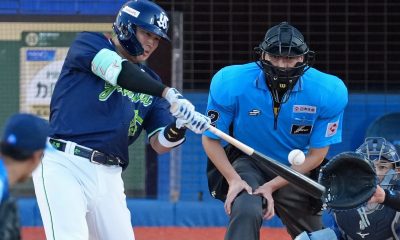




You must be logged in to post a comment Login